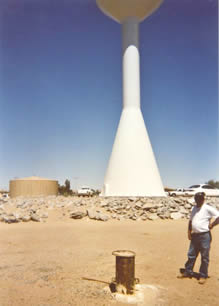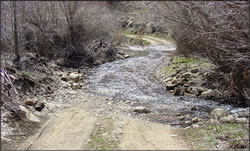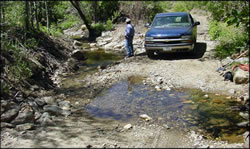Pacific Southwest, Region 9
Serving: Arizona, California, Hawaii, Nevada, Pacific Islands, 148 Tribes
Safe Drinking Water, Clean Waterways: Tribal drinking water, wastewater, polluted runoff projects
Note: EPA no longer updates this information, but it may be useful as a reference or resource.

EPA provided funding in 2003 for dozens of tribal projects to provide safe drinking water, treat wastewater, and prevent polluted runoff, including:
Drinking water
- In 2003, EPA's Drinking Water Tribal Set-aside Program provided
$3.1 million for nine projects serving five tribes, making drinking
water safer for about 13,000 homes.
- With aid from the USDA, Indian Health Service and EPA's Tribal Set-aside Program, the Cocopah Tribe drilled two new wells, constructed a 500,000 gallon storage tank, upgraded their water distribution system, and built an iron and manganese treatment facility.
EPA's Tribal Border Infrastructure Program
Between 1996 and 2003, EPA's Tribal Border Infrastructure Program provided $28.4 million to improve the drinking water and wastewater systems for tribes within 62 miles of the U.S./Mexico Border. This has provided 7,765 homes with safe drinking water, and 1,888 homes with better wastewater disposal facilities.

- The Tohono O'odham added continuous disinfection units to 71
drinking water sources under this program. A new well was drilled
for the Manzanita Tribe to eliminate rising nitrate concentrations
in their water supply.
- The Pala Band of Mission Indians installed three new drinking
water wells, and completed a non-point source pollution assessment.
- The Ak-Chin Community developed its own Long-Term Water Quality Monitoring Program, removed and closed about 100 septic systems, and connected all homes, government buildings, and businesses to their new Wastewater Treatment Plant.
Preventing polluted runoff


- The Shoshone-Paiute Tribes of Duck Valley Indian Reservation restored sections of Skull Creek, which had been degraded by four
vehicle crossing points.
- The Yurok Tribe removed 131 vehicles from a riparian area, removed
592 gallons of toxic pollutants, and planted 7,400 native trees
to restore the area.
- The Ak-Chin Community replaced over 475 invasive salt cedar
trees, which guzzle far more water than other trees, with native
cottonwood and screwbean mesquite trees.
- The Hopi Environmental Protection Office coordinated with local
livestock associations, resource conservation districts, and community
members on several watershed restoration projects. With EPA assistance,
the Hopi Solid Waste Program cleaned a riparian area marred by
illegal dumping.
- The Robinson Rancheria's Water Pollution Prevention and Control
Program worked with community members and groups to control erosion
and restore a local creek. Volunteers transplanted sedge plants
(used for basket making) and thinned out gray willows. The willow
stakes were then used to revegetate another streambank.
- The Hualapai Tribe got EPA funding to repair and replace 120 miles of their reservation's border fence, to keep cattle out of their streams.
- 10 tribes submitted approved Nonpoint Source (polluted runoff) Assessment Report & Management Programs; 54 tribes are eligible to receive funding for watershed restoration projects.

Clean water enforcement
The Black Mesa Pipeline, which transports coal slurry from the Peabody Western Coal Company's Black Mesa Mine near Kayenta, Ariz. to the Southern California Edison Company's Mohave Generating Station in Laughlin, NV, paid $55,000 in penalties for coal slurry leaks on Navajo land.
Plan for 2004: Safe drinking water, clean waterways
- EPA's compliance work in the Pacific Southwest will include
conducting 80 sanitary survey inspections on tribal lands.
- EPA will focus on operator training for tribes to increase
the proportion of tribal water systems with certified operators
to 73%.
- EPA will manage 55 new tribal water and wastewater projects
through grants to tribal governments and interagency agreements
with the Indian Health Service.
- EPA will provide financial assistance to tribal wastewater
systems serving approximately 7,000 homes, bringing the
total receiving EPA assistance since 1998 to 20,000.
- EPA will assist 95 tribes with 135 water quality protection
grants totaling $10 million.
- EPA will award 10 new grants to tribes for source water assessments and source water protection.
| Pacific Southwest NewsroomPacific Southwest Programs | Grants & FundingUS-Mexico Border | Media Center Careers | About EPA Region 9 (Pacific Southwest)A-Z Index |
